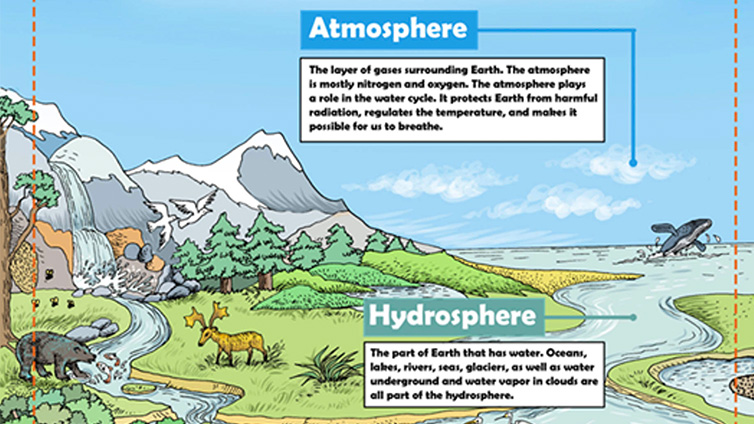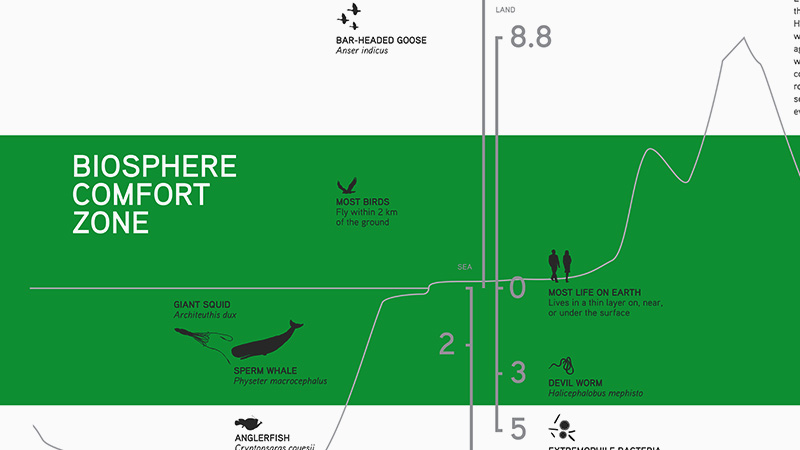Origins of Life
Driving Question: How did life on Earth begin and change?
Journey to the depths of Earth’s early oceans to investigate the origins of life. Then, explore how life adapted and changed as life on Earth evolved.
Learning Objectives:
- Describe the origins of life on Earth and how life changed over time.
- Define the term biosphere.
- Evaluate how geography and climate have impacted life on Earth.
Vocab Terms:
- biome
- biosphere
- DNA
- ecosystem
- homeostasis
- metabolism
- reproduction
Opener: Origins of Life
To teach this lesson step, refer to page 3 of the Lesson 3.2 Teaching Guide.
Make sure to activate student’s prior knowledge as you start this lesson. Check out the our Openers and Closers Guide for more information.
How did this whole “life evolving over billions of years” thing get started anyway?
Life Begins
To teach this lesson step, refer to page 3 of the Lesson 3.2 Teaching Guide.
Check out our Activities Guide to learn more about why these are so important to our course!
There are a few theories about how life on Earth began. The slideshow and activity coming up next walk you through the most commonly accepted theory.
How Did Life on Earth Begin?
How Did Life on Earth Change?
To teach this lesson step, refer to page 4 of the Lesson 3.2 Teaching Guide.
Want to dive deeper into the mini-thresholds of life? Check out this community conversation for extension ideas and samples of student work.
For hundreds of thousands of years, life on Earth was very simple. But, as you’ve seen a bunch in this course already, complexity changes everything. Let’s watch how it happened, and then review the predictions you made.
-
Guiding Questions
-
Before you watch
Preview the questions below, and then review the transcript.
While you watch
Look for answers to these questions:
- What makes the emergence of photosynthesizing cells a mini-threshold?
- What makes the emergence of eukaryotes a mini-threshold?
- What makes the emergence of multicelled organisms a mini-threshold?
- What makes the emergence of brains a mini-threshold?
- What makes the move of sea creatures to land a mini-threshold?
- What makes the emergence of mammals a mini-threshold?
After you watch
Respond to this question: What mini-threshold (or mini-thresholds) might be left out of this list?
Key Ideas
The Biosphere
To teach this lesson step, refer to page 5 of the Lesson 3.2 Teaching Guide.
Check out the OER Project Reading Overview for advice on how to use infographics with your students.
The biosphere is Earth’s “comfort zone.” It’s the rich, fragile environment where most living organisms exist. Use this article and activity to learn more about how the biosphere protects us from extremes that can be dangerous for life.
-
Guiding Questions
-
Before you read
Preview the questions below, and then skim the article. Be sure to look at the section headings and any images.
While you read
Look for answers to these questions:
- Why did Eduard Suess coin the term biosphere?
- What are two examples of biomes?
- What is one similarity and one difference between biomes and ecosystems?
- What are some factors that make ecosystems different from each other?
After you read
Respond to this question: How can geography and climate impact different ecosystems in the biosphere?
Geography and the Biosphere
To teach this lesson step, refer to page 6 of the Lesson 3.2 Teaching Guide.
Check out the OER Project Data Literacy Guide for using charts and graphs in the classroom.
Do you think you could live in a place that gets a lot of rain? What about one that’s always cold? Test your map-reading skills to determine how climate impacts Earth.
Geography: Climographs
Closer: Origins of Life
To teach this lesson step, refer to page 8 of the Lesson 3.2 Teaching Guide.
You’ve learned about the beginning of life on Earth and how life changed over time. Surely something that epic deserves a poem? Try your hand at an Ode to Life Itself!
The Collector
To teach this lesson step, refer to page 9 of the Lesson 3.2 Teaching Guide.
Late in her life, Ynés Mexía became the first Mexican American female botanist. Despite male colleagues’ attempts to prevent her, she introduced hundreds of new species to science during her travels.
-
Guiding Questions
-
Before you read
Preview the questions below, and then skim the comic, paying attention to things like prominent colors, shapes, and types of text and fonts. How do you know where to start and in which direction to read? What’s in the gutters (the space between panels)? Who or what is the focus of the comic?
While you read
Look for answers to these questions:
- Why does the comic call Mexía a “late bloomer”?
- Why was Mexía’s career significant to the study of life?
- What do Mexía’s quotes tell you about how women in the field of botany were treated?
- How has the artist designed the page, text, and illustrations to tell you about Mexía?
After you read
Respond to this question: What does Ynés Mexía’s story tell you about the diversity of life on Earth?
Mysteries of the Origins of Life
There is still so much that we don’t know about the origins of life on Earth.
-
Guiding Questions
-
Before you listen
Preview the questions below, and then review the transcript.
While you listen
Look for answers to these questions:
- Where did Darwin think the origins of life on Earth began?
- Why do some scholars think that life may have originated deep in the ocean?
- Why is it possible that early life on Earth may have been killed off?
- What is LUCA?
- For how many years of Earth’s history may there have been unsuccessful experiments of life?
After you listen
Respond to this question: What do you think is the most plausible explanation for how life on Earth began? Explain your reasoning.




























